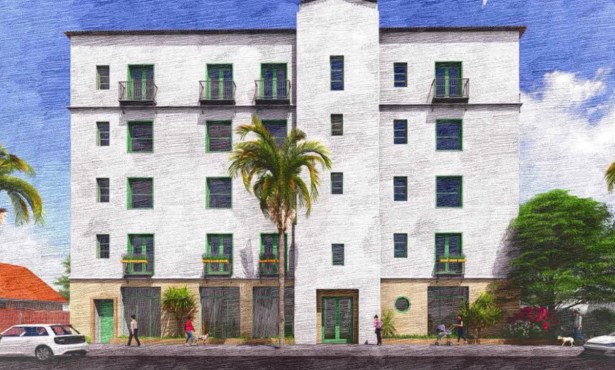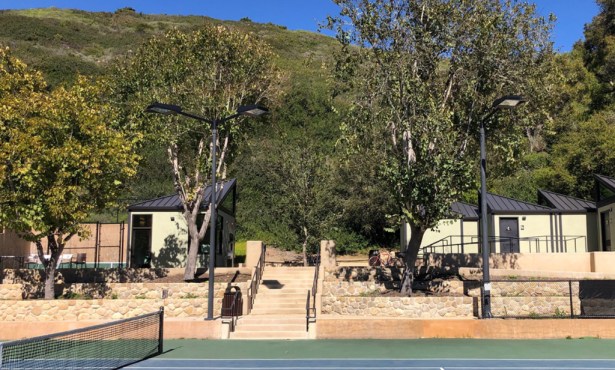Upper State Lofts in Limbo
Berkus’s Uptown Project Deemed Too Much of a Good Thing
The Santa Barbara City Council sent a tough message late Tuesday
to developers with plans on the drawing board for upper State
Street: The rules of the game are changing dramatically, and City
Hall intends to craft a new vision of what sort of development will
be allowed there. After six hours of intense deliberations, the
council voted 6-1 to reject architect Barry Berkus’s controversial
State Street Lofts proposal, a three-story mix of commercial space
and 55 one-bedroom condominiums slated for a spot now occupied by
the deteriorating Plaza Inn and adjoining office building at the
congested intersection of State and La Cumbre streets. In so doing,
six of the councilmembers — only Roger Horton dissented — rejected
the recommendation of their own planning staff, and snubbed a 6-1
vote in favor of the project by the city Planning Commission last
December.
Councilmembers praised Berkus for his creativity and integrity,
and hailed his attempt to provide affordable housing; in the end
their concerns were too great that Berkus’s plans were simply too
big and too much for the traffic-plagued location to bear. Given
that there are several other major proposals currently in the works
for upper State Street — or “uptown,” as it was frequently referred
to during deliberations — councilmembers expressed an urgent need
for a comprehensive public planning process to address upper
State’s long festering problems and to achieve a new consensus of
what’s desirable there. The council scrambled to not reject
Berkus’s lofts outright, and tried to devise a measure that would
free him from starting from scratch or paying the city’s
substantial development fees should he submit revised plans for the
site in keeping with the yet-to-be-determined new vision for the
neighborhood. But Berkus was having none of it. Visibly anguished
by the council’s decision, the developer said, “It seems to me
there’s a de facto moratorium and that many projects on State
Street will be stopped here tonight.” Berkus also indicated that if
he were to try again, he’d propose precisely what the zoning now
allows for and seek none of the special modifications and variances
he’s spent the past 18 months trying to secure. And that, he
predicted, would be 34 multimillion-dollar condos and only five
“affordable” units, as opposed to the 17 below-market units in his
now-dead plan.
In recent weeks, Berkus and his project inspired supporters and
critics alike to flood the council offices with emails, faxes, and
phone calls. At Tuesday night’s City Council meeting, 55 members of
the public were registered to speak, and dozens more showed up
after the registration deadline expired. They were split fairly
evenly for and against the project. Supporters stuck closely to
Berkus’s own script; the project provided three times the
affordable housing that was required and at prices — from $175,000
to $219,000 — that were genuinely within the reach of middle-class
professionals who would otherwise be forced out of town. Not only
would the “greenest” of building technologies be used in
constructing the Lofts, but residents of the Plaza Inn — most of
them living on fixed incomes and struggling with various
challenges — would be relocated. In addition, $10 million of
Berkus’s proceeds from the land sale would be donated to literacy
programs. The package was attractive enough that Berkus’s threat of
withdrawal gave councilmember Roger Horton serious pause.
Councilmember Helene Schneider worried the rejection would send a
negative message to developers trying to give City Hall what it
claims to want. The opposition countered that upper State Street
was desperately crying out for a comprehensive plan, and that by
issuing “piecemeal” approval of big projects like the Lofts before
such a plan was in place, the council would effectively preclude
that from occurring. They noted that the Lofts would serve as a
precedent for other major projects — like the Whole Foods store
proposed for the Circuit City plaza and the dramatic expansion
proposed for the Sandman Inn. They took heated exception to bland
assurances by traffic engineers that traffic congestion on upper
State Street was not getting worse and that projects like the Lofts
would actually improve it; such pronouncements not only defied
logic, they argued, but contradicted their personal experience. And
many critics charged that City Hall needed to tighten its
relocation requirements — for displaced businesses as well as the
indigent motel dwellers. Perhaps most striking about the opposition
were the disparate and often feuding factions that Berkus managed
to unify. Not only did it include the usual slow-growth and
no-growth suspects such as the Citizens Planning Association, the
League of Women Voters, Allied Neighborhood Association, and
Citizens for Sensible Planning, but also prominent
affordable-housing advocates, like Mickey Flacks, who have actively
pressed City Hall and the Board of Supervisors for increased
housing densities that neighborhood preservationists insist will
destroy their quality of life. Three candidates for the 2nd
Supervisorial District — Joe Guzzardi, Janet Wolf, and Das
Williams — weighed in against the Lofts; only Dan Secord, a close
personal friend of Berkus, avoided the fray. In addition, former
Santa Barbara mayor Sheila Lodge voiced her opposition, as did
former councilmember David Landecker. It was Councilmember Das
Williams who made the motion to deny the project, but it was really
Councilmember Brian Barnwell who eviscerated the Lofts during a
detailed dissertation on its shortcomings. A former planning
commissioner, Barnwell had encountered Berkus projects before and
found that their reality — once construction was
complete — sometimes exceeded expectations in terms of size, bulk,
and scale. Because of this, Barnwell said he studied the Lofts
plans in considerable detail and concluded that their height, mass,
and visual impact was out of character with the neighborhood, and
its traffic plans insensitive to the serious circulation needs of
the area. The $64 million question remains: What now? It will be
hard enough for city planners to craft a public planning process
capable of finding consensus for upper State Street’s future,
harder still to do so quickly. In the meantime, what happens to
Berkus? What happens to Whole Foods and the Sandman Inn? And is
there a de facto moratorium in effect, as Berkus charged? “I don’t
buy that for one minute,” said Barnwell, “but I sure as hell hope
the other developers out there are paying attention and get the
message.”


